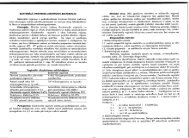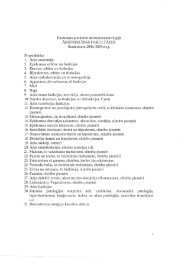PHYSICS
n - susliks.lv
n - susliks.lv
- No tags were found...
You also want an ePaper? Increase the reach of your titles
YUMPU automatically turns print PDFs into web optimized ePapers that Google loves.
Home Work 2. For the Plant Protection students:<br />
A student measured the stem elongation rate (I = mm . day:") of<br />
three plants for 10 days grown under the same conditions and obtained<br />
the following data.<br />
Variant I I (mm . day?")<br />
1 64 81 68<br />
2 69 73 78<br />
3 64 75 70<br />
4 66 71 54<br />
5 56 78 68<br />
6 92 79 74<br />
7 75 68 73<br />
8 74 77 69<br />
9 69 62 79<br />
10 61 68 70<br />
Determine the: arithmetic mean; deviation; dispersion; sample standard<br />
deviation; confidence intervals of random, systematic and total<br />
errors; and relative error of the stem elongation measurements (confidence<br />
interval of systematic error ~c = I; confidence probability<br />
P = 0.95).<br />
Utilize the rules of data approximation.<br />
p<br />
Chapter 3. MECHANICS<br />
!I""II!i~9t;'·"""~Il-"'·~"~,""''ll;~''fio.Jf,~;~or~~~;jJiil:~~'''''J-'i~~~tJi'k1<br />
Mechanics is the branch of physics which deals with the motion<br />
of material objects and their interaction.<br />
3.1. KINEMATICS<br />
Kinematics is a subdivision of mechanics which is concerned<br />
with the study of motion using the concepts of space and time,<br />
without regard to the cause of the motion.<br />
3.1.1. Average Velocity<br />
The x-cornponent of the average velocity of a particle « V» is<br />
defined as the ratio of its displacement (Ax) to the time interval<br />
(M):<br />
16<br />
_!:i.x _ X f - Xi (3 1)<br />
< V >--- .<br />
!:i.t tf - t i<br />
Example. A particle moving along the x axis is located at x; (10m) at<br />
t; (I s) and at xI (6 m) at t (3 s). Find its displacement and the average<br />
l<br />
velocity during this time interval.<br />
Solution. The displacement is given by:<br />
.-ix = xI - x; = 6 m - 10m = - 4 m<br />
3.1.2. Instantaneous Velocity<br />
The instantaneous velocity (V) equals the limiting value of the<br />
ratio !:ix/M as !:it approaches zero:<br />
n !:ix<br />
V = Im- (3.2)<br />
61 ....0 !:it<br />
In calculus, the limit is called the derivative of x with respect<br />
to t, and is written dx/dt:<br />
li sx dx<br />
V = Im-=- (3.3)<br />
6 H O !:it dt<br />
Example. The position of a particle moving along the x axis varies in<br />
time according to the expression x = 4t 2 , where x is in m, and t is in s.<br />
Find the instantaneous velocity at any time.<br />
Solution. We can compute the velocity at any time (t) by using the<br />
definition of the instantaneous velocity. If the initial coordinate of the<br />
particle at time t is Xi = 4t 2 , then the coordinate at a later time (t + M)<br />
is:<br />
xI = 4(t + M)2 = 4[t 2 + 2tM + (M)2] = 4t 2 + 8tM + 4(M)2<br />
Therefore, the displacement in the time interval is:<br />
~x = xI - Xi = 4t 2 + 8tM + 4(M)2 - 4t 2 = 8tM + 4(M)2<br />
The average velocity in the time interval is:<br />
!:ix x -x.<br />
=_=_1__' 8t+4M<br />
!:it t l<br />
-t i<br />
The find the instantaneous velocity, we take the limit of this<br />
17






